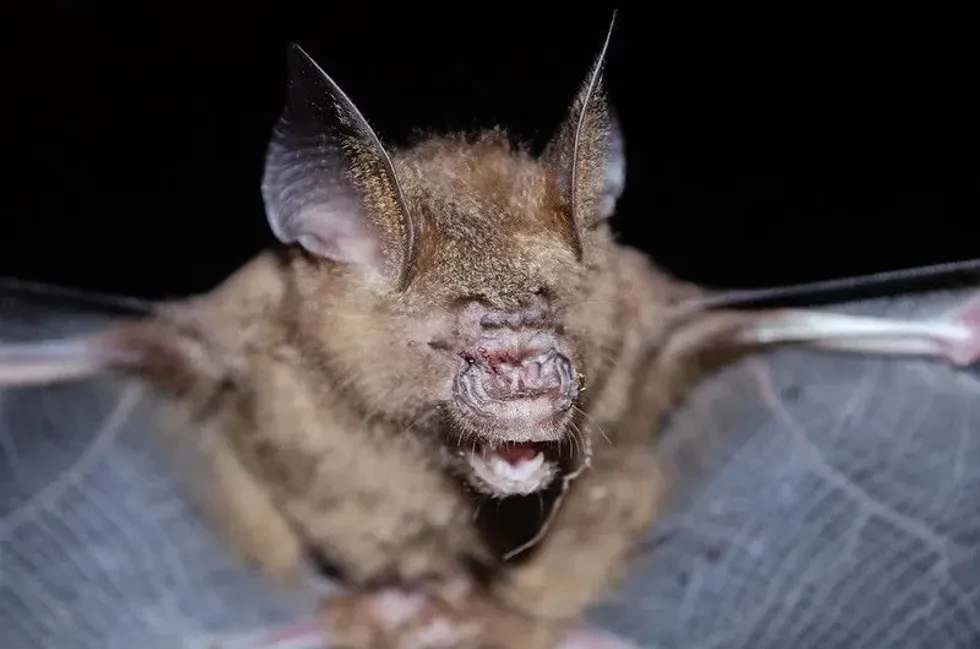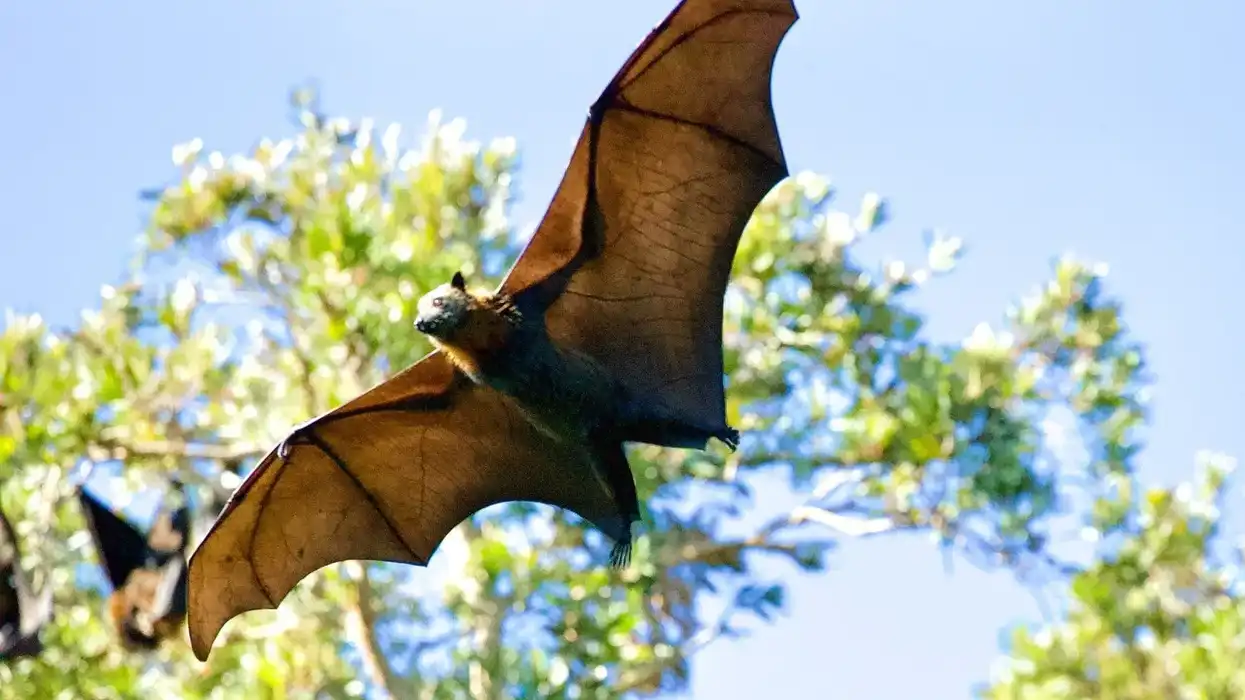The leaf-nosed bat (Phyllostomidae) is a New world leaf-nosed bat or American leaf-nosed bat of the family Phyllostomidae. There are over 160 species in seven subfamilies and more than 55 genera.
These species occupy a range from Southern North America through South America and extend from the southwestern United States through northern Argentina. These species are insectivorous and frugivores.
However, the largest bat in the Americas, the spectral bat (Vampyrum spectrum), feeds on small vertebrates. These vampire bats are known to feed on blood.
The names of these bats are mainly derived from their lance-shaped noses. Also, the nose-leaf feature is believed to be evolved to reflect the foraging and dietary behaviors of the species in this family. These species are either black, brown, or gray in color.
However, five species of this family are white. This bat roosts in abandoned caves, buildings, and under folded leaves.
The type genus of this family is Phyllostomus, which contains four recognized species. Some threats faced by these bats are agricultural infestation, habitat loss, and particularly the California leaf-nosed bat is sensitive to human disruption.
If these leaf-nosed bat facts were interesting, then learn about the hoary bat and Mexican free-tailed bat to learn more about bats.
Leaf-Nosed Bat Interesting Facts
What type of animal is a leaf-nosed bat?
The New world leaf-nosed bat is endothermically a mammal and bilaterally symmetrical. This bat species has a high wing load and low wing aspect ratio and this allows them to hover to feed on fruits, pollen, and insects.
These species of bats are active at night. Phyllostomidae roosts in caves, drain pipes, buildings, and other vegetation.
Uroderma genus leaf-nosed bats use broad leaves to make tents for roosting by chewing the midrib of the leaf to fold into a tent and small groups of bats roost under it.
Almost all the Phyllostomids do not exhibit reduced body temperature except in Heller's broad-nosed bats, Pallas' long-tongued bats, and Seba's short-tailed bat's aestivation is possible. Desmodus species displays aggressive behavior, food sharing, and reciprocity.
What class of animal does a leaf-nosed bat belong to?
New World leaf-nosed bats belong to class mammals of animals.
How many leaf-nosed bats are there in the world?
The exact population number of New World leaf-nosed bats is not yet known.
Where does a leaf-nosed bat live?
The geographic habitat range of the New World leaf-nosed bat from the United States covering the West indies and southern Arizona through Northern Argentina and central Chile and in many Caribbean islands. California leaf-nosed bat (Macrotus californicus) is found in Mojave and Sonoran deserts in Arizona, California, western Mexico, and Nevada.
What is a leaf-nosed bat's habitat?
This family of the New World leaf-nosed bat occupies a wide range of habitats across forests and deserts. The leaf-nosed bat habitat includes temperate, tropical, forests, deserts, caves, and buildings. They also prefer a habitat with dense rainforests and high elevation.
Who do leaf-nosed bats live with?
The New World leaf-nosed bat species can either be solitary creatures or may form colonies or groups while roosting.
How long does a leaf-nosed bat live?
The New World leaf-nosed bat is usually long-lived for their small-sized bodies. The average lifespan of these species is around seven years.
How do they reproduce?
This family of new world leaf-nosed bats has various reproduction systems which depend on roosting habits and social structure. However, only 7.5% of the mating systems of this family are known.
The currently known monogamous member of this family is the Spectral leaf-nosed bat. Most members of this family are polygynous. The reproduction systems of Jamaican leaf-nosed bat, pale spear-nosed bat, vampire bat, and greater spear-nosed bat have been described as Polygynous, harem-based.
Also, the Honduran white bat and California leaf-nosed bat display seasonal polygynous aggregations like forming leks or colonies. Spermatogenesis is year-round for males but the Hipposideros species stores sperm for copulation. Excluding the Waterhouse's leaf-nosed bats subspecies, both ovaries are functional in egg release in this family.
These species usually give birth to a single pup. The gestation period of these species is 40 days to eight months.
Weaning takes place in a range between six weeks to 10 months. Only females provide parental care, which needs a lot of energy due to a long gestation period for a large-sized well developed young one.
Female bats feed and nurse the young. Females reach their sexual maturity earlier than males, which reached in one to two years. The female spectral bats do not provide parental care.
What is their conservation status?
The conservation status of the leaf-nosed bats varies with species in the family. The California leaf-nosed bat (Macrotus californicus) is listed as Least Concern by the IUCN Red List of Threatened Species.
25 species in this family are listed as Vulnerable and four are listed Endangered. Mass eradication programs, habitat loss, deforestation, and pesticides are the main threats to these bats.
Leaf-Nosed Bat Fun Facts
What do leaf-nosed bats look like?
The nose-leaf is the main characteristic of these animals. This feature also allows them to detect high-frequency sounds. The nose-leaves are made of fleshy plate surrounding the nasal apertures, which stands straight behind these openings.
They can have broad or slender and short or long nose leaves. The species in the Phyllostominae subfamily have well-developed nose leaves whereas, in vampire bats, the nose leaf is highly modified into complex series of bumps and folds around the narial plate.
Tooth structure, body size, and head shape determine the dietary habits of these bats. These bats have large eyes and narrow snouts. The Phyllostomid subfamilies have varying physical appearances based on their dietary needs.
California leaf-nosed bats are the only species in this family to have large ears. Carnivorous bats have robust molars and canines.
Insectivores have sharp-crested teeth. Species of the Glossophaginae subfamily have facial whiskers and round ears. Frugivore species have reduced molars, round mouths, flat faces, and long wings.

How cute are they?
These bats have large ears and nose-leaf, which stands out in these animals. However, many are creeped out by bats.
How do they communicate?
The leaf-nosed bat uses echolocation, ultrasound, visuals, heat, and chemicals to communicate.
How big is a leaf-nosed bat?
The leaf-nosed bat size range is 1.6-5.3 in (4-13.5 cm) body length. California leaf-nosed bats are just the size of an average leaf-nosed bat with 2.3 in (6 cm) body length. This family of bats consists of various-sized bats.
How fast can a leaf-nosed bat fly?
The flight speed of these species varies with varying dietary requirements. Insectivore bats are fast-flying bats in this family.
How much does a leaf-nosed bat weigh?
The weight of leaf-nosed bats is 0.015-0.44 lb (7-200 g).
What are the male and female names of the species?
There are no specific names given to the female and male leaf-nosed bats.
What would you call a baby leaf-nosed bat?
The baby leaf-nosed bat is referred to as a pup.
What do they eat?
The leaf-nosed bat diet varies among the species. Their diet type can either be herbivorous, omnivorous, or carnivorous. Many of these animals are nectar and fruit-eating bats. However, vampire bats feed on blood. These bats carry their food to night roosts, found around foraging territories, to eat without the fear of predators.
Are they aggressive?
Yes, these species are aggressive while protecting their territories.
Would they make a good pet?
No, these bats are wild animals. These species thrive in their natural habitats.
Did you know...
The California leaf-nosed bat is the most maneuverable than other species in flight.
The frugivores and nectivores disperse seeds. These species pollinate more than 1,000 plants.
The orange leaf-nosed bat and griffin's leaf-nosed bat are two among the many living old-world bat species.
Like most bats, these animals cannot crawl on their toes and thumbs.
Their hearing abilities are so sharp that they can even hear a cricket's footsteps.
Types of leaf-nosed bats
There are over 180 species within 55 genera.
A few of them are: California leaf-nosed bat (occupies Mexico, Arizona, Nevada, and California), short-tailed leaf-nosed bat or Short-tailed leaf-nosed fruit bat (occupies Brazil, America, Mexico, Argentina), Lesser great leaf-nosed bat (occupies Japan), Long snouted and Mexican long-tongued bats are desert dwellers, Semon's leaf-nosed bat (occupies Papua new guinea and Australia), Giant leaf-nosed bat or Commerson's leaf-nosed bat (occupies Africa and Madagascar island), Mexican long-nosed bat or greater long-nosed bat (occupies the United States and Mexico), Hairy little fruit bat (occupies Ecuador and Colombia), Southern long-nosed bat (occupies South America), Tree bat (occupies Saint vincent and the Grenadines, Saint Lucia, Saba, Montserrat, Dominica, Netherlands Antilles, and Martinique), Guianan spear-nosed bat (occupies South America), Yellow-throated big-eared bat (occupies central and south America), MacConnell's bat (occupies central and south America), Red fig-eating bat or red fruit bat (occupies U.S Virgin Islands and Puerto Rico), Hart's little fruit bat or Velvety fruit-eating bat (occupies northern South America, Central America, the United States, and Mexico).
What are the predators of leaf-nosed bats?
There are no specific leaf-nosed bat enemies or natural predators. However, the list of leaf-nosed bat predators includes snakes, falcons, owls, cats, and skunks, as these animals are the primary predators of bats.
Here at Kidadl, we have carefully created lots of interesting family-friendly animal facts for everyone to discover! For more relatable content, check out these ghost bat facts and red bat facts pages.
You can even occupy yourself at home by coloring on one of our free printable leaf-nosed bat coloring pages.









